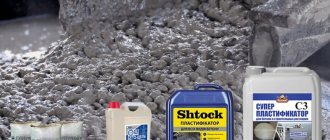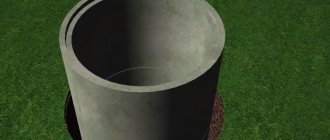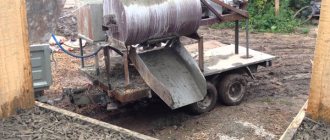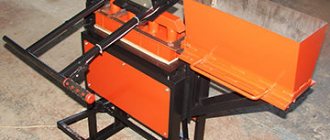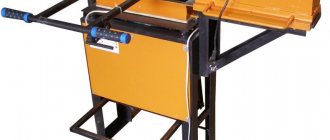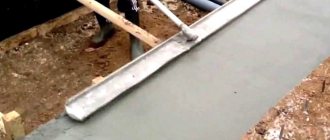From the author: Hello, dear readers. We try to monitor all advanced construction technologies and highlight them on the pages of our website. This time we will talk about polymer concrete, or “artificial stone”.
The material was created in the USA and is now actively used by developers in Europe and Russia for the construction of residential and utility rooms, household items, sculptures, as well as in the manufacture of furniture. Its demand poses a difficult task for the consumer: is it possible to make polymer concrete with your own hands?
After all, manufacturing technology requires highly specialized knowledge and skills. We will study the technical characteristics of the coating and determine how to make polymer concrete yourself without the involvement of builders.
Characteristics
Polymer concrete is resistant to moisture and mechanical factors. It reacts normally to temperature changes. The composition hardens quickly, adhering well to any base. The material is elastic and breathable. It does not react with chemical agents.
The main characteristic of the polymer-cement mixture is environmental safety.
Polymer concrete does not emit substances that negatively affect human health and the environment. The mixture can be used in the construction of public catering facilities.
Composition of polymer concrete
The composition of the building mixture includes the following components:
- Coarse filler. Broken glass, crushed stone, and sand are used as this element.
- Fine filler. The introduction of such a component reduces the cost of the product. The filler is graphite or quartz.
- Connecting link. A polymer resin, such as polyester, furan, urea-formaldehyde or epoxy, is added to the mixture. Polymer concrete contains 5% binder.
- Auxiliary additives. These include substances that increase elasticity and frost resistance, giving the composition the desired color.
Application
Due to the presence of many positive properties, polymer concrete has a fairly wide range of applications. It is used in landscape design, laying out paths and terraces. A similar mixture is used to decorate walls, both externally and externally, and decorate borders, stairs, fences, swimming pools, and plinths. This material can easily be worked by hand. It produces different shapes, figures, and decorative elements. Its beauty is that it is easy to paint after drying.
The use of such a building mixture is suitable for pouring floors. Polymer concrete floors will provide excellent protection against moisture. Polymer concrete floors will keep your home warm.
Return to contents
Production technology
In the production of building materials, 2 technologies are used:
- Periodic. In this case, the container is cleaned after each cycle of material production. Polymer concrete can be produced using a concrete mixer or a simple basin.
- Continuous. The technology is used by large enterprises. The conveyor includes injection molding units, dispensers and automatic mixers.
In the manufacture of polymer concrete products, molds treated with a release agent are used. The composition makes it easy to extract the finished product. The mold is made from silicone, wooden boards, fiberglass or metal.
The manufacturing process includes the following steps:
- Preparation. The mold is treated with a release agent and covered with gelcoat of the required color range.
- Creation of the composition. Fillers and polymer additives for concrete are thoroughly mixed using a mixer.
- Laying the mixture into molds. At large enterprises, concrete pavers are used at this stage. When making products in a small workshop, the action is performed manually.
- Vibration compaction. Vibration is used to impart the desired properties to the mixture. The duration of this stage is 2 minutes. Factories use a resonant vibration platform. Small enterprises are supplied with vibrating tables.
In industrial conditions, polymer concrete products are subjected to heat treatment. This reduces the drying time of the product. In other cases, hardening occurs under natural conditions.
Advantages and disadvantages
A huge number of positive properties elevate the cement-polymer construction mixture over conventional concrete. Due to the rapid hardening with polymer concrete, the first work can be done within a few days, which cannot be said about conventional material. The new type of concrete is much more durable and stronger. For complete hardening, it only takes one week, and not a month, as for ordinary cement.
Among the positive properties of the polymer mixture is waste-free production. Previously, all agricultural and construction waste was simply thrown away or buried in the ground, thereby polluting our nature. Now the recycled material is used to make polymer concrete. The use of such technology not only solves the problem of waste disposal, but also protects the environment from pollution.
Unfortunately, this building material also has disadvantages. Among the negative properties, one can highlight the inclusion of artificial materials in the composition. The second negative point is the high cost of some additives necessary for the preparation of polymer concrete. Due to this, the price of the finished product increases.
Return to contents
Advantages of the material
Polyconcrete has a number of positive qualities that make it possible to use the material when classic concrete does not provide the desired result.
Thanks to the smooth surface, it is easy to remove dirt.
The advantages of the composite composition include the following characteristics:
- Resistant to high humidity. Drops of water quickly evaporate from the surface without having time to be absorbed.
- Insensitive to temperature changes. Products do not deform when rapidly heated or cooled. The quality of the material does not depend on the number of freezing cycles. In the production of concrete mixtures, polymer is used instead of traditional cement or silicate.
- Resistance to aggressive substances. The coating is not damaged by disinfectants and solvents. This allows you to avoid using additional surface treatment methods.
- Possibility of restoration of damaged areas. The composite mass is restored using special mixtures.
- Increased strength. With a low weight, this characteristic is not inferior to that of classic concrete.
- Surface smoothness. No unevenness is formed during the manufacture of products. The material does not slip and does not wear off. This avoids contamination of the coating. If necessary, the surface is washed using the usual methods.
- Recyclable. The material is used in the creation of technological waste. This reduces the cost of the product produced using waste-free technology.
Reviews
Polymer concrete has not been widely adopted due to the high costs and difficulties associated with traditional production technologies. However, recent progress has led to significant cost reductions, meaning its use is gradually becoming more common. Despite all its advantages over conventional concrete, there are opinions about hidden negative environmental factors, which often occur due to improper production, the use of low-quality components and improper proportions.
Also, the technology for producing polymer concrete has many nuances and secrets that no one wants to reveal. And of course, as reviews note, the market price of polymer concrete is quite high. This is due to the difficulties of its production and the expensive components that are used to create it.
Features and scope of use
Polymer concrete is used for the manufacture of the following products:
- Countertops. Kitchen elements made from this material are characterized by increased strength, hygiene and a long service life. They fit well into any interior. Countertops made of polymer concrete do not differ from products made from natural stone.
- Floors. Floor coverings are resistant to stains and easy to install. The surface is plastic, resistant to mechanical damage, and has an aesthetic appearance. A layer 2 mm thick can be used for 10 years.
- Decorative parts of facades. Polymer concrete is no different from marble or granite. Polymer products are lightweight, so they can be installed without creating a massive base.
- Monuments and fences. The polymer array is resistant to atmospheric factors, which allows it to be used for decorating ritual objects.
Requirements for reinforcing plastics
It is recommended to use polyolefin grades (polyethylene, polypropylene) as a reinforcing component They successfully combine strength and flexibility, which allows them not to break under load.
Polyolefins are characterized by frost resistance, which will allow the reinforcing additive to withstand atmospheric influences and even work at subzero temperatures.
Plastic exhibits its reinforcing properties most when a large ratio of the length and width of the pieces is maintained.
Therefore, high-quality and correct reinforcing material can be obtained by extruding and cutting the corresponding polymer on a chipping machine .
Types of polymer systems
The term polymer concrete refers to a wide group of building mixtures that differ in composition and production methods.
Plastic concrete group
Plastic concrete is a mixture based on artificial resins. Cement is not used in its manufacture.
Plastic concrete is used in the production of finishing materials.
There are 2 types of material:
- Filled.
The amount of binder component is 20-50%. Resin fills the space between the filler and the aggregate.
- Frame.
It has a porous structure. The polymer is used to hold the core frame together. The volume of the binder component in the mixture does not exceed 6%.
The properties of the material are determined by the type of fillers, polymers, and auxiliary additives introduced. Furfural acetone mixtures should not be used for finishing premises. Epoxy and methacrylate compounds are safe for humans and animals.
Compared to classic concrete, plasty concrete has higher levels of moisture resistance, frost resistance and elasticity. The disadvantage is that it wears out quickly.
Polymer cement systems
The composition of such materials includes cement.
Polymer cement floors.
The mixture is prepared in 3 ways:
- Mixing the base with aqueous solutions of polymers - polyvinyl acetate or artificial rubber.
- Introduction of a dispersion of polymers or monomers. The most commonly used are furan alcohol and epoxy resins.
- Impregnation of concrete. Polymer components, such as urea or styrene, are introduced to the required depth.
The recommended volume of the binder component is 15-20%. This allows you to maintain the structure of the cement composition. As the polymer content increases, products lose strength. Sand or fine crushed stone is used as filler. Polymer-cement mixtures are used to create wear-resistant floor coverings.
Concrete-polymer compositions
Concrete polymer is a hardened cement mixture, onto the surface of which liquid impregnation is applied. The material contains metal acrylate resins and catalysts, which harden in the structure of the mineral framework.
The disadvantage is the presence of a large number of pores that appear during the production stage of products.
Such defects reduce strength and resistance to aggressive substances. Filling the pores with polymer helps improve the performance of the composition.
Column made of polymer concrete.
Geoconcrete
In construction, materials are increasingly being used that use natural components in their production. Geopolymer concrete is similar to classic concrete, but the performance characteristics are slightly different. The structure resembles that of natural stone.
Low cost makes the material in demand among individual developers. Geoconcrete is used for the construction of multi-story buildings and the creation of decorative elements.
Polymer impregnated concrete
Polymer impregnation for concrete is usually made by incorporating a low-density monomer into hydrated Portland cement, followed by radiation or thermal catalytic polymerization. The modular elasticity of this type of concrete is 50-100% higher than that of conventional concrete.
However, the modulus of the polymer is 10% greater than that of normal concrete. Thanks to these excellent characteristics, among the many options for using polymer building materials, we can specifically mention the production of:
- decks;
- bridges;
- pipes;
- floor tiles;
- construction laminate.
The technology behind the incorporation process involves drying the concrete to remove moisture from its surface, using the monomers in a thin layer of sand, and then polymerizing the monomers using heat flow. Consequently, concrete surfaces have lower water permeability, absorption, abrasion resistance and generally high strength. Also, to increase wear resistance, resistance to cold and moisture, polymer varnishes are used for concrete, brick, stone, floors, etc.
DIY cement-polymer concrete
The process of making polymer concrete with your own hands includes the following steps:
- Preparation of components. The crushed stone is cleaned of foreign matter and washed. The sand is passed through a sieve. The moisture content of the fraction should be no more than 1%. Therefore, the sand is thoroughly dried.
- Mixing. The components are placed in a concrete mixer. First of all, crushed stone is laid, then sand and aggregate. The ingredients are mixed for 2 minutes. After introducing water, the procedure is repeated.
- Preparation of the binder component. The resin is softened by adding a solvent. The finished substance is mixed with a plasticizer.
- Introduction of a binder component with a hardener and prepared concrete mixture. After introducing the hardener, the composition is stirred for 3 minutes.
The finished composition must be poured into molds immediately.
Production of polymer concrete: material properties
Along with concrete mixtures for general construction purposes, in the practice of building structures, special ones prepared using special technologies are increasingly being used. This category includes polymer-modified concrete. Polymer concrete is a highly filled composition made on the basis of synthetic resins and chemically resistant fillers, without water, and sometimes without mineral binders.
Its production is based on almost any synthetic binders, fillers and fillers. However, the price and shortage of some synthetic resins have determined a relatively narrow range of polymer components.
Polymer concrete: composition, characteristics
The main performance properties depend on the chemical nature of the synthetic resin, the content and type of the fine fraction of fillers.
Industrial manufacturing technology is based on the use of resins of the following modifications:
- furanic;
- polyester;
- urea.
Types of synthetic resins for material production: brief description
Furan resins are the result of the condensation of furfural with ketones and phenols. This type, due to its low cost, significantly surpasses its competitors.
- The binder in this group of components is usually furfural acetone monomer. A liquid with a high boiling point, insoluble in water, but soluble in esters and ketones. Hardening of the FA monomer occurs with the help of sulfonic acids, sulfonic chlorides, etc.
- Basic requirement The use of aggregates that interact with acids (limestone, dolomite, etc.) is unacceptable.
- Polyester resins The process of hardening occurs due to methyl ethyl ketone peroxide or isopropylbenzene hydroperoxide and reaction accelerators - activators. The cheaper and more common is the polyester maleate variety.
- Ureas are products of the synthesis of urea and formaldehyde in aqueous solution.
- Curing enzymes are organic and inorganic acids, as well as: zinc and ammonium chlorides, aniline hydrochloride. The latter is used most often.
- Dispersed mineral fillers have a significant impact on the quality of the material. Thanks to their varied characteristics, it is possible to regulate the properties.
- Thus, the addition of carbon-containing fillers significantly increases their moisture and frost resistance.
Fillers: quartz flour, andesite, interacting with polyesters, help increase strength.
In this video you can get acquainted with the technology of lightweight polymer concrete.
Fillers and excipients
The production of products must meet one main condition - technological proportions must be strictly observed, because For any type of synthetic resin, there are strictly defined degrees of filling that provide maximum strength to the product. Mineral fillers act as thinning additives, significantly reducing the cost of the material.
The increased content of aggregates and fillers allows:
- reduce the consumption of polymer binder, the price of which significantly affects the final cost;
- limit temperature and shrinkage deformations;
- control the strength, density, hardness and other physical and mechanical properties of products.
An invariable condition for the use of fillers and aggregates is their chemical compatibility with catalysts and hardeners. The fillers are dispersed powders (polymer or mineral) with a particle size of no more than 0.15 mm.
The most common fillers are:
- andesite powder;
- diabase powder;
- marshallite powder;
- cement;
- graphite.
The degree of their impact on the properties directly depends on their chemical component, particle shape and dispersion, state of the base, percentage content, etc.
The coarse aggregate is crushed stone, the size of the fraction is selected based on operating conditions, size and shape of the product. Crushed stone and sand perform the functions of the skeleton of the structure of the product, and do not affect the quality indicators of operational characteristics. The use of crushed stone from sedimentary rocks is not allowed.
The most common compositions of material based on furfural acetone monomer are shown in the table below:
Features of industrial production technology
The production equipment is presented in the form of a technological diagram for the production of polymer concrete on a production line at one of the industrial enterprises (see photo) and consists of the following items:
- raw materials warehouse;
- bunkers for receiving sand and crushed stone;
- drums for drying materials;
- dispensers;
- turbulent concrete mixer;
- vibration platform;
- heat treatment chamber;
- forms;
- stock.
Production equipment
Selecting the composition of polymer concrete
First, the most dense composition of fillers is experimentally selected, then the volume of microfiller is calculated, which should correspond to the number of voids, plus 10% of the volume. Then the required amount of resin and hardener is calculated to achieve the desired mobility of the mixture. The hardener is calculated taking into account the type of resin and hardening conditions.
Tips: – Excessive volume of resin leads to undesirable consequences: increased shrinkage, thermal deformation and weakening of strength.
Preparation of polymer concrete mixture
So, polymer concrete: production technology.
Preparation of the composition for production in an industrial enterprise consists of two stages:
- Preparation of binders by mixing the calculated parts of the resin, plasticizer, microfiller and hardener in a turbulent-type concrete mixer for 30 s.
- Mixing the finished binder with small and large components in forced action mortar mixers.
The solution is made by simultaneously mixing dry components (crushed stone and sand) with a pre-prepared binder, which is added in doses to a continuously operating concrete mixer. The duration of mixing the dry composition is 1.50–2.00 minutes. The time for mixing the dry binder composition should not exceed 2 minutes.
The mixer must have special temperature sensors and an emergency system for supplying water in case of an accident in case of violation of the production technology - to quickly stop the reaction of polymer structure formation.
Forming and heat treatment of polymer concrete products
The finished mass is sent to a stacker with a mobile hopper with a special distribution device, which evenly smoothes the solution according to the shape of the designed product.
- Compaction is carried out on a resonant vibration platform with horizontal vibrations.
- Compaction and placement of the mortar must be done in a closed workshop equipped with ventilation.
- The duration of the vibration compaction process is 2 minutes.
- Heat treatment of finished products is carried out in modes that ensure the complete completion of the stages of polymerization of resins that serve as binders.
If the heat treatment mode is incorrectly selected or the process flow diagram is not followed, shrinkage and deformation processes will continue in the finished products, which will significantly affect the quality of the material.
Application of polymer concrete
High strength, increased abrasion resistance, positive physical and chemical properties make it possible to use them in the most critical areas of civil and industrial construction.
This material is most in demand in the construction of the following structures:
- irrigation dams and wear-resistant structures of port facilities;
- production of chemically resistant coatings for industrial buildings, waste gutters and other critical structures with increased performance properties;
- chemically resistant drainage pipes, mine shafts and underground communications collectors;
- drain wells and various tanks for aggressive liquids;
- contact supports for power lines and other similar structures with increased electrical resistance;
- in civil engineering: for the manufacture of internal and external decorative elements of buildings and structures.
